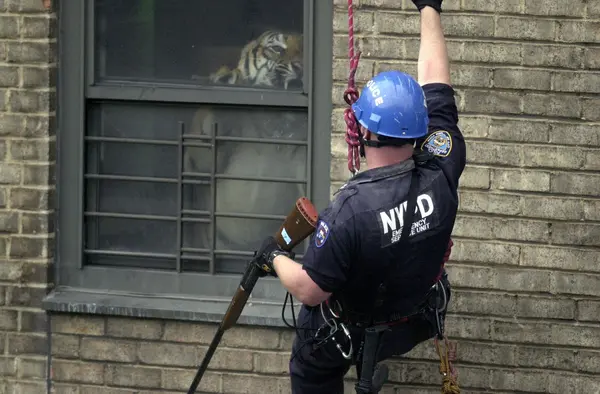Cats are a popular mascot worldwide, and most feline breeds adapt well to indoor environments as long as they’re fed regularly and given plenty of affection.
Some cats, though, are just not meant to be kept as household pets. A big cat is one type of cat most people wouldn’t want to see stalking around their living room.
Most people, but not all. That’s something the New York Police Department discovered when they were called upon to extract Ming, a fully grown tiger, from an apartment in the Upper Manhattan neighbour of Harlem.


Who Owned The Harlem Tiger?
The person who thought a tiger would make the ideal pet for him was a man called Antoine Yates. Yates was a construction worker and part-time cab driver who lived in a Harlem housing project, the Drew-Hamilton Houses.
The fact that Yates lived on the 21st floor of a tower block and had no outside space in which to accommodate an animal like a tiger wasn’t a deterrent to him acquiring one.
While his apartment was definitely not the ideal habitat for dangerous animals, Yates had a penchant for the exotic. He had no qualms about turning his home, the bathroom of which served as a reptile house for Al, a two-metre-long alligator, into a zoo.
He also never seemed bothered by the fact that he could have been eaten alive by Ming or Al at any time.
What Kind Of Tiger Was Ming?
Ming had the genetic make-up of two different kinds of tigers: a Siberian and a Bengal. He was part of a litter born at a Minnesota sanctuary called the Bearcat-Hollow Animal Park.
Whether Ming’s parents were bred intentionally or accidentally isn’t known, but by 2005, the owners of the park would be residing in jail after being found guilty of breeding and trafficking endangered animals and the park was closed down.
When Yates purchased Ming from the sanctuary, the cub was only eight weeks old and had to be bottle-fed until it was old enough to consume meat.
Only Yates knows precisely how long it took for Ming to make the dietary transition from milk to ten kilos of chicken and offal a day, but make the transition he did.
By 2003, when Ming’s presence in Harlem became public knowledge, Ming was a three-year-old, mature adult male tiger that weighed around two hundred kilos.
Siberian tigers are the largest of the big cat species, and Bengal tigers are not far behind them size-wise, so Ming was never going to be a small animal.
In the wild, a tiger’s territory can cover anywhere from 60² km to 100² km, and an adult tiger can prowl up to 50km a day in search of prey.
How Ming coped with being cooped up in the restricted space of Yates’ Harlem apartment is anyone’s guess.
Ming, The Legend Of Harlem
While Yates’ neighbors were aware that he kept exotic animals, nobody really believed he had a tiger in his apartment. Ming’s existence was treated by most Harlem locals as an urban myth.
How they remained unaware of Ming’s presence is strange as a tiger’s roar at full blast can reach over a hundred decibels. That’s a noise level equivalent to a subway train passing by or a rock concert in full swing.
Ming’s mythical existence eventually turned into a real-life fact after Yates took another feline, albeit a regular house cat, into the apartment. Only Yates knows exactly what happened the day he ended up in the hospital after being mauled by Ming.
At the time, he told several news reporters that he had been trying to save the cat from being bitten by Ming, but had ended up being bitten himself.
Even though Yates’ injuries were severe enough to warrant a visit to the emergency room, he didn’t admit the truth about how he’d got bitten or what had bitten him to the medical staff that attended him.
The doctors treating Yates’ wound realised they had never seen a jaw imprint as big as what they were seeing on Yates’ arm.
The bite marks were colossal and bigger even than those an XXL Pitbull would leave behind. Afraid there was a dangerous animal on the prowl in Harlem, someone from the medical team called the police, asking them to investigate the incident.
How Was Ming Rescued?
When a NYPD officer, who wasn’t as hard of hearing as the neighbors, arrived at Yates’ apartment door and heard Ming growling, he did what any intelligent person would do in the circumstances – he ran.
Then began the complicated operation of removing Ming.
It took the combined effort of a team of police officers, animal welfare officers and veterinarians to carry out Ming’s rescue.

Getting Ming out of the confined space without hurting him and without Ming hurting any of the officers involved would prove to be no easy feat.
Ming’s extraction operation commenced with an NYPD sharpshooter abseiling from the rooftop of the building down to the window of the room Ming was in.
The officer then shot a tranquilising dart through the glass, which, after a few minutes, sent Ming to sleep. Once the extraction crew knew Ming was well under the effects of the tranquiliser dart, they broke into the apartment.
Ming was given additional sedative injections to make sure he didn’t wake up while they loaded him onto a gurney.
The team then took the doped tiger down to the ground floor in the lift and into a waiting van that was loaded with a transport cage. Ming wasn’t the only animal to be taken out of Yates’ apartment that day, Al was rescued too.
What Happened To Ming?
Even though he would never be able to be released into the wild or be able to adapt to life in a zoo, life improved a lot for Ming after he was removed from Yates’ apartment.
Once he’d been secured in the transport cage, Ming was taken eight-hundred kilometres across the country to a sanctuary in Berlin, Ohio.
The refuge that rehomed Ming was the Noah’s Lost Ark Animal Sanctuary. It was, and still is, a non-profit, no-kill animal sanctuary that specialises in exotic animals.
After his arrival there, Ming was provided with a suitable enclosure where he was able to live out the rest of his life in relative comfort. Ming passed away in 2019 at the age of nineteen from natural causes related to ageing.

What Happened To Antoine Yates?
Antoine Yates recovered from the injuries he received from Ming but didn’t get to go straight back to his Harlem home. Yates was arrested for the illegal possession of a wild animal.
He was also charged with endangering the lives of others. Found guilty of both charges, Yates was sent to prison, where he served a short sentence before being released on probation.
It is distressing to think of an amazing creature like Ming being kept in an apartment with barely enough space to move around.
While it’s true Yates was irresponsible in keeping Ming, he was actually very fond of his big cat and meant it no harm.
Yates is no longer able to keep exotic animals like Ming, but he will be forever known in the annals of New York history as the undisputed Tiger King of Harlem.
Sources
https://www.nytimes.com/2020/04/18/nyregion/ming-tiger-harlem-nyc.html
https://911animalabuse.com/bearcat-hollow/embed/#?secret=Yqa7nvqqDw#?secret=k0bRabQC97
https://www.kingston.ac.uk/research/research-showcase/research-case-studies/ming-of-harlem/













Leave a comment